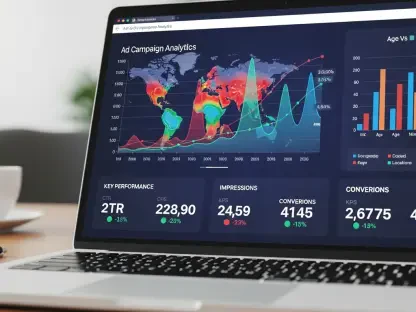Market Shock: Unraveling a $40 Billion Collapse in Adtech
In a single day this August, The Trade Desk (NASDATTD), a titan in programmatic advertising, saw its stock plummet by an astonishing 40%, erasing $40 billion in market value. This seismic event has sent shockwaves through the investment community, spotlighting the fragility of high-growth tech stocks in a sector driven by innovation and fierce competition. The collapse raises urgent questions about whether this represents a fleeting setback or a fundamental shift in the company’s outlook. This market analysis aims to dissect the forces behind the decline, explore current trends shaping the programmatic advertising landscape, and project potential trajectories for The Trade Desk amid operational challenges and industry evolution. By examining key data points and competitive dynamics, the goal is to equip investors with a clear perspective on navigating this turbulent moment in adtech.
Deep Dive into Market Dynamics and Projections
Triggers of Turmoil: Operational Failures in Focus
The immediate catalyst for The Trade Desk’s dramatic stock drop centers on its highly anticipated Kokai AI platform, which promised to revolutionize ad campaign optimization. Despite the hype, the platform has faced significant hurdles, including technical glitches and sluggish adoption by key clients, leading to widespread disillusionment among stakeholders. This misstep has not only dented investor confidence but also highlighted potential flaws in strategic planning at a time when AI capabilities are becoming critical in the adtech space. The market’s reaction reflects a broader skepticism about whether the company can maintain its edge without delivering on such pivotal innovations.
Beyond the product-specific issues, securities litigation has compounded the damage. Class-action lawsuits allege that the company overstated Kokai’s potential, misleading investors about its readiness and impact. The revelation of substantial insider stock sales—amounting to $465 million—during the period under scrutiny has further fueled concerns about transparency and governance. These legal challenges introduce a layer of uncertainty that could linger, impacting sentiment and potentially leading to financial penalties or reputational harm.
Valuation Shifts: Reassessing a High-Growth Stock
Before the collapse, The Trade Desk commanded a price-to-earnings (P/E) ratio of 66, towering over the S&P 500 average of 29 and signaling lofty expectations for uninterrupted growth. Post-plunge, the P/E ratio has recalibrated to approximately 40, aligning more closely with industry peers but still reflecting optimism for future expansion. This adjustment prompts a critical debate: did the market initially overvalue the stock due to unchecked enthusiasm, or has the correction gone too far, undervaluing a company with strong fundamentals? The current valuation might tempt value-seeking investors, though unresolved risks suggest caution in interpreting this as a straightforward bargain.
Market analysts note that such re-ratings are common in tech sectors where growth narratives are tested by execution. The Trade Desk’s ability to rebound will likely depend on demonstrating tangible progress in addressing operational setbacks. For now, the stock’s trajectory remains a balancing act between discounted pricing and persistent uncertainties, with investor sentiment hanging in the balance as quarterly updates loom.
Industry Landscape: Navigating a Transformative Adtech Era
The programmatic advertising market, valued at $678 billion in 2023, continues to expand at a robust compound annual growth rate (CAGR) of 22.8% projected through 2030. However, the sector is undergoing a profound transformation, driven by privacy regulations phasing out third-party cookies and a pivot toward first-party data and contextual targeting. Premium inventory in private marketplaces now dominates, representing 91% of U.S. programmatic display spend, a shift that challenges companies like The Trade Desk, which have historically thrived on open internet exchanges.
Emerging segments such as connected TV (CTV) and retail media networks, growing at a 29.3% CAGR, are reshaping competitive priorities. Rivals leveraging walled gardens and advanced AI tools are gaining traction, exposing gaps in The Trade Desk’s adaptation to these high-growth areas. Projections indicate that U.S. video ad spend could exceed $110 billion by next year, underscoring the urgency for the company to diversify its focus and strengthen its technological offerings to remain relevant in a rapidly evolving ecosystem.
Competitive Pressures: A Battle for Market Share
Against this backdrop, The Trade Desk faces intensified competition from players better positioned in premium and privacy-focused environments. Companies with integrated solutions for CTV and retail media are capturing significant market share, capitalizing on advertisers’ growing preference for targeted, data-secure platforms. The Trade Desk’s slower pivot to these trends risks eroding its once-dominant position, particularly as advertisers allocate budgets toward channels offering measurable returns in a post-cookie world.
This competitive landscape suggests a narrowing window for the company to reclaim leadership. Market data points to a fragmented adtech sector where innovation cycles are accelerating, leaving little room for prolonged missteps. If The Trade Desk fails to address its AI integration challenges or expand into emerging formats, it could face sustained pressure, even as overall industry growth remains strong. The stakes are high, with long-term success hinging on strategic agility and execution.
Reflecting on the Path Forward: Strategic Insights
Looking back, the analysis of The Trade Desk’s 40% stock collapse reveals a confluence of internal failures and external pressures that precipitated a historic market event. The underperformance of the Kokai AI platform, coupled with legal entanglements, exposed vulnerabilities in a company once celebrated for its innovation. Industry shifts toward privacy-first models and premium inventory further complicated the narrative, highlighting competitive disadvantages that demand immediate attention. Moving forward, investors should closely monitor updates on technological advancements and litigation resolutions as critical indicators of recovery potential. A diversified approach to adtech investments could mitigate risks while capturing sector growth, and patience will be key for those considering an entry at current valuations. Ultimately, the challenge lies in balancing the promise of programmatic advertising’s expansion with the tangible hurdles The Trade Desk faces, ensuring decisions are grounded in evolving market realities rather than past assumptions.









